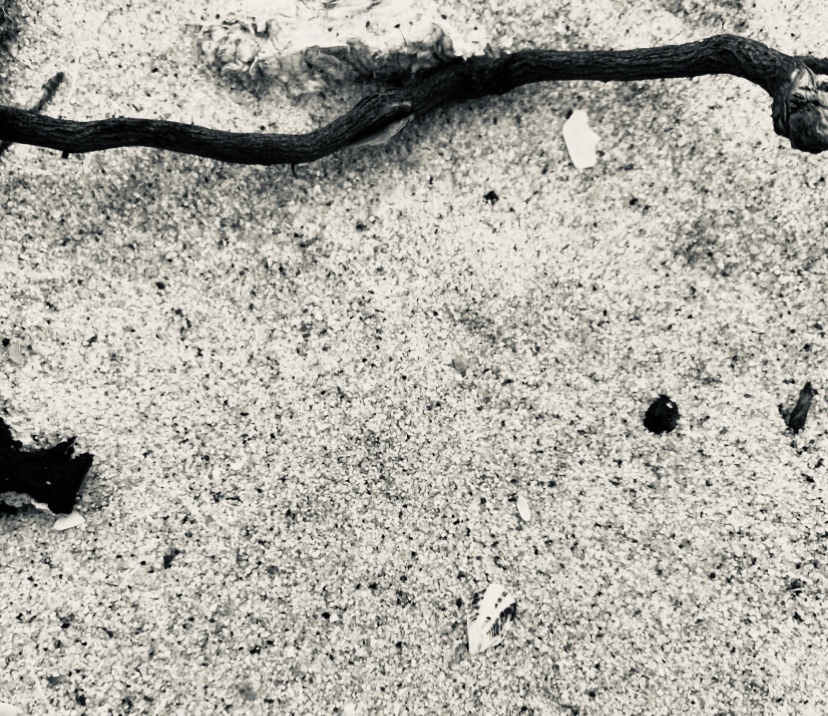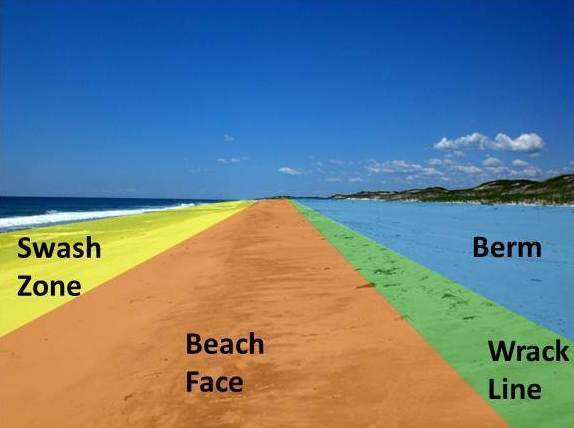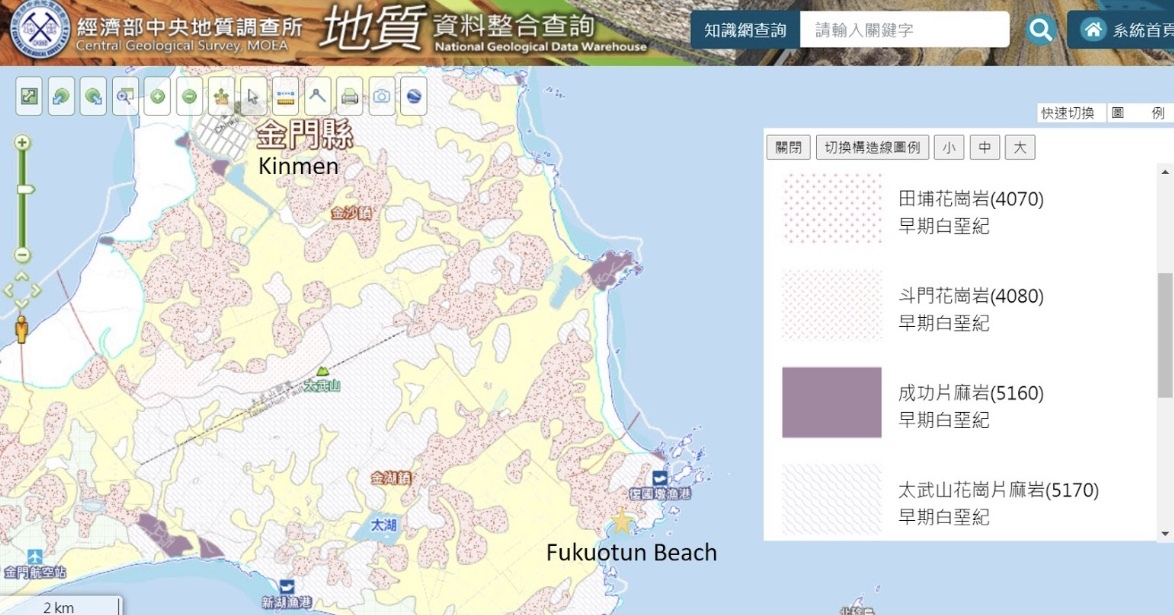萬磁王,第一課。 #復國墩
復國墩位在金門東側海岸,岩石海岸上的涼亭是欣賞日出的最佳地點。復國墩海岸有一段是沙灘,很少遊客會拜訪這座沙灘。復國墩沙灘並非純白色的沙,反而有一些特殊的黑砂。
 (照片變色處理)
(照片變色處理)
這個地質寶要做什麼?
探索沙灘以辨識沙子的組成與成因。
復國墩沙灘成因
復國墩附近沒有天然的河流或是湖泊,這座沙灘是海浪活動的結果,海水中的小粒子被海浪攜帶與堆積至弧形海岸邊,復國墩海灘屬於海灣,沙子隨著海流堆積至海灣內,風與植物根系統也是形成這座海灘的重要影響因子。
海灘上石頭與沙等物質的來源可能來自離岸岩石,這些岩石受到侵蝕作用影響而形成石頭與沙物質在堆積至海灘,這座海灘上的石頭與沙比較少來自岸邊岩石或是懸崖的墜落物,海洋中的珊瑚礁石也可能是海灘沙子的重要來源。
金門海岸的岩石受到海洋侵蝕作用影響,包含水力作用、磨耗作用、溶蝕作用、磨蝕作用(Abrasion or Corrasion),這些侵蝕作用會在岩石上造成裂縫,或是讓岩石變成小石頭或更小的沙子。
海灘剖面、海灘顏色與沙子
海灘依據地貌特徵可區分為四個部分,分別受到海浪不同的影響程度。溯升帶為持續有海浪溯升的區域,灘面為會受到海浪溯升的斜面,乾濕線/最大溯升處為每日潮汐最高上升位置,有機質與無機質碎屑受海浪作用堆積在此處,灘台則通常為乾燥的海灘,除非特別高的潮汐或暴風雨影響。海灘剖面在不同季節會受到不同海浪能量的影響。

Photo Author: National Park Service
海灘沙子的成分仰賴當地礦物與地質。白色沙子可能含有較多石英與石灰石,其他影響沙子為白色的礦物有長石或石膏。熱帶白沙的顏色與碳酸鈣有關,來自貝殼、珊瑚等海洋生物骨骼。粉紅色沙子則和白沙的礦物相似都與碳酸鈣有關,較多為珊瑚的碳酸鈣。黃色沙子則和不同程度的鐵含量有關。黑色沙子的組成為火山岩石,像是玄武岩與黑曜石。紅色沙子則是火山岩石中礦物鐵氧化的結果。綠色沙子的顏色則來自橄欖石。當地岩石類型、礦物、侵蝕作用、與風化作用全都是海灘沙子顏色的影響因素。
在復國墩海灘可以觀察到海灘的顏色,但是復國墩海灘沙子中的黑沙並不是玄武岩或黑曜石。現在來試著瞭解看看可能是什麼。
復國墩主要岩石類型
金門主要地層與露頭屬於1億4千5百萬至6千6百萬年前的白堊紀,復國墩的岩層為花崗岩(4070)與花崗片麻岩(5170),花崗岩屬於火成岩,而花崗片麻岩屬於變質岩,正片麻岩承受高溫高壓後變質,原始岩石可能為火成岩,如:花崗岩。花崗片麻岩為金門獨特的岩石。沿著復國墩海岸可以觀察到這兩種岩石,這個區域也經常可以看到岩脈。

金門花崗岩主要礦物組成包含石英、正長石、斜長石,少數礦物則有黑雲母、磁鐵礦與鈦鐵礦。
金門花崗片麻岩主要礦物組成包含石英、長石、雲母、角閃石,少數礦物則有綠泥石、綠簾石、絹雲母、與其他鐵鎂礦物。
黑雲母、磁鐵礦、鈦鐵礦、與一些鐵鎂礦物是黑色,磁鐵礦與鈦鐵礦可以被磁鐵吸引,非常少數的鐵鎂礦物具有弱磁性。
請準備好以塑膠袋包裹的強力磁鐵來探索這片海灘,嘗試透過探索結果來回答地質寶的問題。
Magneto, First Class. #Fukuotun
The uniqueness of sand on Fukuotun Beach
Fukuotun is located at the east side of Kinmen. The pavilion on rock seashore is a good site for sunrise. A section of seashore at Fukuotun is a sand beach. Few tourists would visit the beach. This beach is not all powdery white sand but with unique black sands. The composition of sand on the Fukuotun beach is unique with special minerals and materials.
 (photo discoloration)
(photo discoloration)
What to do with this earthcache?
Explore the beach to recognize the composition and the formation of sands. Recognize the minerals of a unique type of rock in Kinmen.
Beach formation at Fukuotun
At Fukuotun, there is no natural river and lake nearby. The beach here is the result of wave action bringing and accumulating small particles on the arc of the seaside. The landscape of Fukuotun beach is a bay. Sand accumulated in the bay with ocean currents. Wind and root systems are also important influencing factors on forming this beach.
Beach materials at Fukuotun may come more from erosion of rock offshore rather than headland erosion or slumping producing deposits of cliff. Coral reef offshore may also be a significant source of sand on the beach.
Rocks at the seashore of Kinmen may be affected by coastal erosions, including hydraulic action, attrition, solution, abrasion, and corrosion. Erosion processes can produce cracks on rocks or make rocks into small stones or even tiny particles, like sands.
Beach Profile, beach sand and colors
Beach can be divided by geomorphic features as four sections. They are influenced by different levels of waves. Swash zone is covered and exposed by wave run-up. Beach face is a sloping section exposed to the swash of waves. Wrack line is the highest reach of the daily tide. Organic and inorganic debris are deposited at this line by wave action. Berm is the area that stays dry except extreme high tides and storms. Beach profiles may change in different seasons due to different wave energies.

Photo Author: National Park Service
Beach sand varies in different colors depending on local minerals and geology. White sand may be abundant with quartz or limestone. Other minerals may also be the reason for white color, such as feldspar or gypsum. Tropical white sand gets its color from calcium carbonate from the shell or skeleton of marine organisms, like corals. Pink color sand has similar composition as tropical white sand, mainly calcium carbonate from coral. Yellow-colored sand is relating to different degrees of iron. Black sand composed of volcanic rocks, like basalts and obsidian. Red sand is the result of oxidation of iron from volcanic rock. Green sand gets the color from olivine. Local rock type, minerals, erosion, and weathering are all important factors on the color of the beach.
The sand color of Fukuotun beach can be observed at this earthcache. But, the black sand on the beach is not derived from basalt or obsidian. Let’s find out what it is.
Main types of Rocks in Fukuotun
Main outcrops of Kinmen belong to Cretaceous from 145 MA to 66 MA ago. Rock compositions under Fukuotun are granite (4070) and granite-gneiss (5170). Granite is igneous rock and granite-gneiss is metamorphic rock. Orthogneiss is formed under high temperature and pressure and is derived from igneous rock, such as granite. Granite-gneiss is a unique rock in Kinmen. Along the seashore of Fukuotun, these two types of rock can be observed. Dykes and veins are very common on rocks in this area.

The main mineral composition of granite in Kinmen usually contains quartz, orthoclase feldspar, and plagioclase feldspar; and few minerals are biotite, magnetite, and ilmenite.
The main mineral composition of granite-gneiss in Kinmen contains quartz, feldspar, mica, and amphibole; and few minerals are chlorite, epidote, sericite, and other mafic minerals.
Biotite, magnetite, ilmenite and some mafic minerals are in black color. Magnetite, ilmenite have attraction to a magnet and few mafic minerals have weak attraction to a magnet.

From the basic knowledge above, let's explore the Fukuotun beach with a strong magnet.
Question
Prepared a strong magnet in a plastic bag at posted coordination.

Black Sand and Rock
1.1 Does the magnet work on the rocks on the beach?
1.2 Does the magnet work on all the black sands on the beach?
1.3 Based on the exploration of magnet, what type of rock is probably the origin of the black sand?(Granite/Granite-gneiss) Interpret the answer.
Sand and Beach landscape
2.1 What’s the main color of the beach? What minerals or materials play the main role for the beach’s color?
2.2 Which area is abundant with black sands? (Swash zone/Beach face/Wrack line/Berm)
2.3 Explain why the area (or areas) has more amount of black sand.
3. Explore the beach with a strong magnet covered with a plastic bag. Photo the result of exploring with you, your identifying item, your personal trackable, or your GPS device.
Log this cache "Found it" and send me your suggested answers either via my profile, or via geocaching.com (Message Center) messaging, and I will contact you if there is a problem.
黑砂與岩石
1.1 海灘上的岩石有磁性嗎?
1.2 海灘上所有的黑沙都有磁性嗎?
1.3 根據磁石的探索,這些黑沙比較可能來自什麼類型的岩石?(花崗岩/花崗片麻岩) 請試著說明你的答案。
沙子與海灘地景
2.1 這座海灘的顏色是什麼?你覺得跟什麼礦物或物質有關?
2.2 哪個區域有比較多的黑砂?(溯升帶/灘面/乾濕線、最大溯升處/灘台)
2.3 解釋這區域為什麼有比較多的黑沙?
3. 請使用以塑膠袋包裹的強力磁鐵探索沙灘,將探索結果與你、你的識別物、你的旅行蟲或你的GPS裝置拍照。
線上登錄這個地質寶,請將答案寄到Geocaching.com的信箱,若有什麼問題,會再回覆你。
Note:
You have to prepare a magnet in a plastic bag to explore the beach. Otherwise, it would be difficult to clean the magnet.
請務必準備塑膠袋包裹的磁鐵探索海灘,不然會無法將磁鐵清乾淨。
Landmine were all cleaned in 2013. There were no incidents in recent years. Geocachers can explore the beach with safety. You can stand on rocks to do this earthcache if you still worry about the risk. 金門海灘於2013年排雷完畢,這幾年沒有地雷事件,請玩家可以放心,若仍然擔心風險,請站在岩石上觀察。
感謝
金門縣金湖鎮區公所
金湖鎮溪湖里里長
Reference
Beach @wiki
金門縣科學展覽54屆國小組地球科學第二名:多年國小
花崗片麻岩組成
金門日報 田浦海岸地質之美大地教室
金門常見礦物 花崗岩